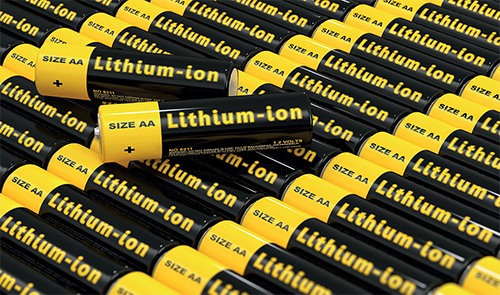
Safe Storage
While lithium-ion battery technology development has advanced over the last few decades, it has also presented new fire and explosion risks. For industrial environments, the proper storage and risk management of lithium-ion batteries is therefore critical.
For the purposes of this article, we will address issues associated with small batteries, which are typically used in electronic devices and hand tools, and larger format batteries, used in mobile equipment such as lift trucks and vehicles.
Each lithium-ion battery consists of cells, in which lithium is the agent for an electrochemical reaction that produces energy. When discharging, lithium ions in the battery cell move from the anode (the negative electrode) to the cathode (the positive electrode) through an electrolytic substance, which is typically a liquid or gel and results in the release of energy from the battery. The process is reversed when the battery is being charged, with ions moving from the cathode to the anode.
Potential safety risks
As well as many benefits, there are potential safety risks related to thermal stability and internal short circuits, which can cause overheating and even explosion. Safety problems arise due to poor design, the use of low-quality materials, incorrect assembly, or damage. Even for lithium-ion batteries with integrated safety features, an unanticipated breach in the battery separator material can result in a high current that overheats the battery’s electrolyte.
While battery manufacturers and developers are continually improving lithium-ion battery design and performance, this can make them more vulnerable to small manufacturing defects or internal damage from the physical impact with another object. Variations in battery design, and the quality of materials and manufacture can also cause potential safety risks. Of course, this problem will be magnified if large quantities of batteries are stored on-site or transported between industrial facilities.
Reduce the risks
Fortunately, there are important steps that operators can take to reduce the risks, including ensuring that the facility is equipped with suitable sprinklers. Idle batteries in storage are not typically subject to internal ignition. However, large-scale testing has shown that lithium-ion batteries behave similarly to unexpanded plastic commodities in a fire. Therefore, sprinkler protection should be provided.
Fully charged lithium-ion batteries have a higher energy density and are therefore at greater risk of generating significant heat from short circuiting caused by internal defects. It is therefore important to ensure that lithium-ion batteries stored in the longer-term are charged at levels below 50 per cent charge capacity and kept at temperatures between 4-27°C. This will help to minimize the risk of thermal runaway from manufacturing defects or internal failures.
While usually safe, as lithium-ion battery charging can cause safety problems, stations designated for charging large format batteries should be separated from other combustible materials by at least one meter. For larger format batteries, such as those used in mobile equipment, battery chargers and batteries being charged should be separated from other combustible contents by at least one meter. Stations used for charging small format batteries should be set on a firm, non-combustible surface and be separated from other combustible materials by at least 30 centimeters.
Before disposing of damaged or unwanted lithium-ion batteries, in waste bins for example, their battery terminals should be covered with insulating material. This will help to ensure that the terminals do not accidentally come in contact with metal or other battery contacts that could close the battery circuit and result in an unintended energy discharge.
Likewise, bins holding damaged or discarded batteries should be separated by at least three meters from all other storage areas, as well as bins holding other potentially combustible materials. This separation will help to reduce the risk of spreading a fire that might originate amongst discarded or waste batteries. In addition, these bins should be metal and have metal lids whenever practical.
Internal components and mechanisms in lithium-ion batteries are highly susceptible to physical or mechanical damage when the battery is subject to a severe external force or when it is dropped on a hard surface. Any external evidence of damage should therefore trigger concerns about a battery’s internal integrity, and it should be safely disposed of in bins intended solely for damaged batteries.
For larger format batteries, such as mobile equipment batteries, ensure that battery chargers and batteries being charged are separated from other combustible contents by at least three meters.
As lithium-ion batteries bring so many positive benefits to product innovation, they will continue to evolve as manufacturers seek new ways to increase battery density and reduce size. Therefore, the safety of lithium-ion battery technology will continue to be investigated to address unexpected hazards that emerge. As we learn more about the risks associated with the use, bulk storage and recycling of lithium-ion batteries, changes in standards and best practices can be expected to change as well. It is therefore vital that the safety of lithium-ion battery technology and its storage remains under scrutiny so that these evolving hazards can be addressed.
 MARTIN FOLEY
MARTIN FOLEY
Martin Foley is Senior Manager at TÜV SÜD, one of the world’s leading experts in product testing and certification, with 150,000 product certificates in circulation globally. Its Product Service division analyses over 20,000 products each year in Europe, Asia-Pacific and the Americas, using its technical expertise to help customers optimize market access.
For further information please visit: www.tuvsud.com/en-us